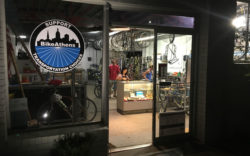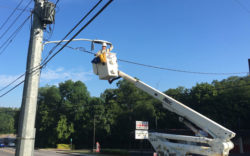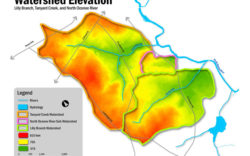The hot days we’ve had so far this spring are just a taste of the summer ahead of us. If you dread your next few months of electric bills, read on for a few tips on getting the most savings out of your thermostat and air conditioner. Before we get to that, though, it’s important to understand how your AC system works, so that you can use it wisely.
Just as water flows downhill, heat flows from hot to cold. If you want to move water against gravity, you need energy to lift it. Similarly, if you want to cool your house when it’s hot outside, you need energy to pump the heat against its natural flow. An air conditioner does this with an electric motor that compresses and expands a refrigerant fluid (what many of us call “Freon”) inside a continuous pipe. When the fluid is pressurized, it gets very hot; when it is forced through an expansion valve, it gets very cold. If you’re old enough to have used Right Guard in a spray can, you experienced a similar cooling phenomenon—brrr!
If you put the cold end of the pipe into a box inside your house and blow air through it with a fan, the refrigerant absorbs heat from the air and cools the house. If you put the hot part of the pipe in a box outside your house, the refrigerant releases that heat to the outdoors. You can witness this on a smaller scale with your refrigerator, which uses electricity to pump heat from your food to your kitchen in the same way. The system is not just making “cold,” it is moving heat from one place to another.
A thermostat is little more than a switch that turns the AC on when the air in the room is warmer than the setpoint and off when the desired temperature is reached. It is not an accelerator pedal or a volume knob. In almost all residential AC units, turning the temperature farther down does not make the system work faster or harder, it just keeps it on longer to reach that lower setpoint. From the lowly mercury dial to basic programmable thermostats to fancy wifi-connected ones like the Nest, they’re all just an on-off switch at their heart.
The only way to reduce your AC system’s energy use is to reduce its daily runtime, and there are two simple ways to do that with your thermostat. The first is to increase the temperature setpoint while you’re out. There is a myth that it takes more energy to cool the house on your return than was saved while you were away, but this is simply untrue. The bigger the difference between the outside and inside temperatures, the faster the heat flows through your walls and windows into your house, and the more time the AC must run to pump that heat back out. Every minute that you set the thermostat closer to the outside temperature is an energy savings opportunity.
The second simple way to save energy with your thermostat is to turn it up while you’re home. Setting it back just a few degrees can make a big difference, especially if you tend to keep your house or apartment at 68 degrees. Adjust it in small increments over a week so you can gradually get used to a warmer setpoint. Fans help to evaporate the sweat on your skin and make you feel like the air is cooler than it really is, so if you use a fan while you turn up the thermostat, it will result in net energy savings. Fans do not cool the air, however, so it’s a waste of energy to leave a fan on in an empty room.
A basic programmable thermostat is a good investment, especially for homeowners, but even for renters. Even if you have to pay your landlord to install one, you will still more than make up the cost in energy savings if you stay for a year or more. However, if you’re diligent about changing the settings every day, you can achieve the same savings with a simple dial.
Like what you just read? Support Flagpole by making a donation today. Every dollar you give helps fund our ongoing mission to provide Athens with quality, independent journalism.










